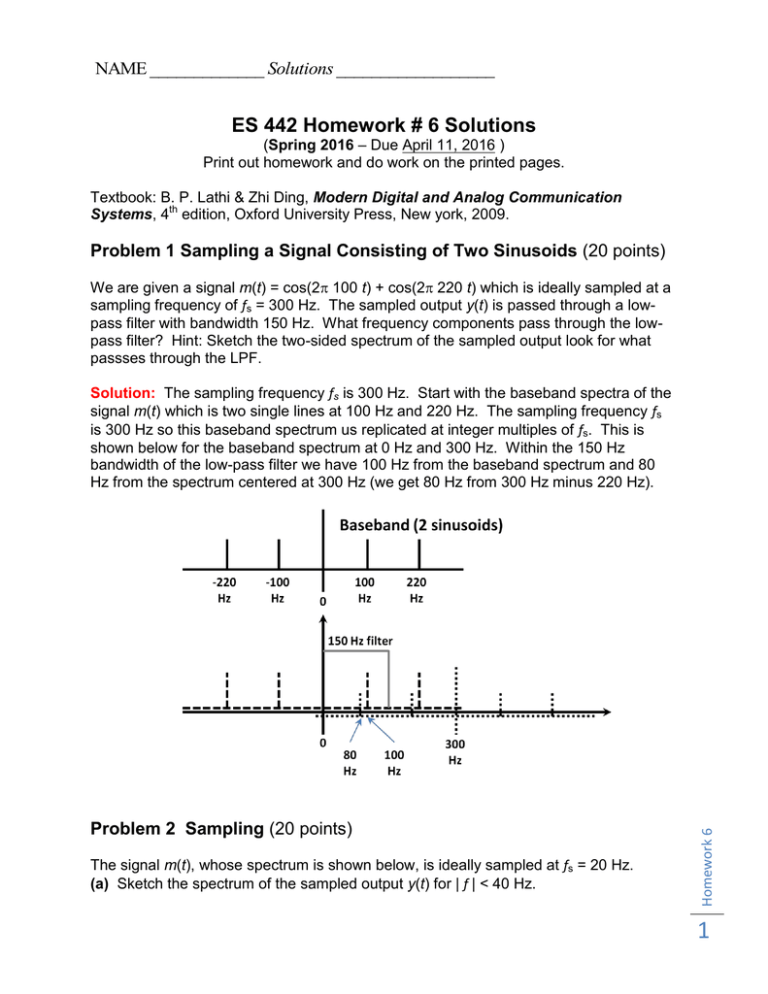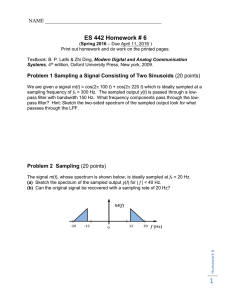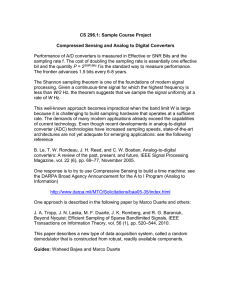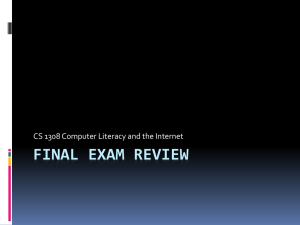Solutions - Sonoma State University
advertisement

NAME _____________ Solutions __________________ ES 442 Homework # 6 Solutions (Spring 2016 – Due April 11, 2016 ) Print out homework and do work on the printed pages. Textbook: B. P. Lathi & Zhi Ding, Modern Digital and Analog Communication Systems, 4th edition, Oxford University Press, New york, 2009. Problem 1 Sampling a Signal Consisting of Two Sinusoids (20 points) We are given a signal m(t) = cos(2 100 t) + cos(2 220 t) which is ideally sampled at a sampling frequency of fs = 300 Hz. The sampled output y(t) is passed through a lowpass filter with bandwidth 150 Hz. What frequency components pass through the lowpass filter? Hint: Sketch the two-sided spectrum of the sampled output look for what passses through the LPF. Problem 2 Sampling (20 points) The signal m(t), whose spectrum is shown below, is ideally sampled at fs = 20 Hz. (a) Sketch the spectrum of the sampled output y(t) for | f | < 40 Hz. Homework 6 Solution: The sampling frequency fs is 300 Hz. Start with the baseband spectra of the signal m(t) which is two single lines at 100 Hz and 220 Hz. The sampling frequency fs is 300 Hz so this baseband spectrum us replicated at integer multiples of fs. This is shown below for the baseband spectrum at 0 Hz and 300 Hz. Within the 150 Hz bandwidth of the low-pass filter we have 100 Hz from the baseband spectrum and 80 Hz from the spectrum centered at 300 Hz (we get 80 Hz from 300 Hz minus 220 Hz). 1 (b) Can the original signal be recovered with a sampling rate of 20 Hz? Solution: The bandwidth B of the baseband signal is 20 Hz. The sampling theorem says we must sample at twice the highest frequency (which is B in this case. So with as sampling rate of only 20 Hz, in general we can not expect to be able to recover the baseband spectrum because of aliasing. However, this is a special case where the baseband spectrum is void of frequencies between 0 and 12 Hz, so we could actually recover this the baseband signal in this special case. Problem 3 Time Domain Multiplexing (20 points) Assumption: All three signals use the same sampling rate. Homework 6 Three signals (m1(t), m2(t) and m3(t)) are to be multiplexed. Signals m1(t) and m2(t) both have a 5 kHz bandwidth, however, signal m3(t) has a 10 kHz bandwidth. Design a commutating (rotating) switching system so that each signal is sampled at its Nyquist rate. 2 Problem 4 S0/Nq for PCM (15 points) A low-pass signal m(t) with a 3 kHz bandwidth and an amplitude range from -5 volts to +5 volts is sampled at the Nyquist rate. It is then converted to an eight-bit code using uniform quantization. The mean-squared value of the message signal S0 is 2 voltssquared. (a) Calculate the normalized power for quantization noise Nq. (b) Calculate the signal-to-quantization noise ratio (S0/Nq) in decibels (dB). Solution: (a) The mean square quantized noise power is 2 mp2 2 q 2 3L 12 and mp is the range of m(t) which is 5 volts in this case. For 8 bits, L = 256 levels, hence q2 = 1.27 10-4 V2 = Nq. By “normalized” we mean the resistance is taken to be one ohm for power calculations. For part (b) we have m 2 (t ) 2 S0 3 (256)2 15,728 3L2 2 mp 25 Nq S 10 log 0 10 log 15,728 41.97 dB N q Problem 5 PCM for CDs (25 points) A compact disc recording system samples each of the two stereo signals with a 16-bit analog-to-digital converter with a sampling rate of 44.1 kHz. (a) Determine the output signal-to-quantized noise ratio (S0/Nq) for a full amplitude Solution: We will assume that mp is one volt for convenience. Sixteen bits translates into 65,536 levels. The mean square quantized noise power (into 1 ohm) is given by 2 mp2 2 q 2 3L 12 If mp = 1 volt and L = 65,536, then Nq = q2 = 7.76 10-11 volt2. Homework 6 sinusoidal signal. 3 Now the signal power for a range of -1 volt to +1 volt in peak voltage is 1 watt assuming it is into 1 ohm. The SNR [S0/Nq] = 1/(7.76 10-11) = 12,884,901,888 numerically and SNRdB = 101 dB. (b) The bit stream of the digitized data is augmented by the addition of error correcting bits, clock extraction bits, etc. These additional bits represent an overhead of 100% (in other words the number of bits per second is doubled). Determine the output bit rate with the overhead bits included for stereo operation. Solution: We sample at 44,100 Hz with 16 bits per sample, thus, we have 705,600 bits per second for one channel. But we are told that the overhead is 100%, so that we must have 1,411,200 bits per second, and given that stereo has two channels (left ear and right ear), we double that again. The total number of bits per second is then 2,822,400 bits per second. (c) The CD disc can record approximately 1 hour of music. Determine the number of bits stored on a typical CD from the above information. Homework 6 Solution: In one hour we have 3600 seconds, therefore, 2,822,400 bits/second times 3600 seconds gives us 10.16064 Gbits/CD. 4



